Horses, Camels, Medical emergencies, and Isolation
Host: Hodgson River Station
Written by Jo Bloomfield – Owner, Hodgson River Station.
This week I was trying to look at different aspects of ‘change’ in the northern beef industry. Today I’m using some old photos from my husband’s family to consider some points of how things have changed from the early 1900’s and through that century to now.
Bloomfield’s and their horses
The Bloomfield’s at one stage bred horses for the Indian remounts when Australia was at war. Thoroughbreds were mainly bred with the Walers on the property and also crossed with Percherons and heavy horses for use in stock work. Bronco horses were used to pull up calves to a panel to brand on property and thoroughbred crosses used for stock horses. The Bloomfield’s loved their horses and were keen racehorse breeders way back then and to this day some of the family are still in the horse racing industry.
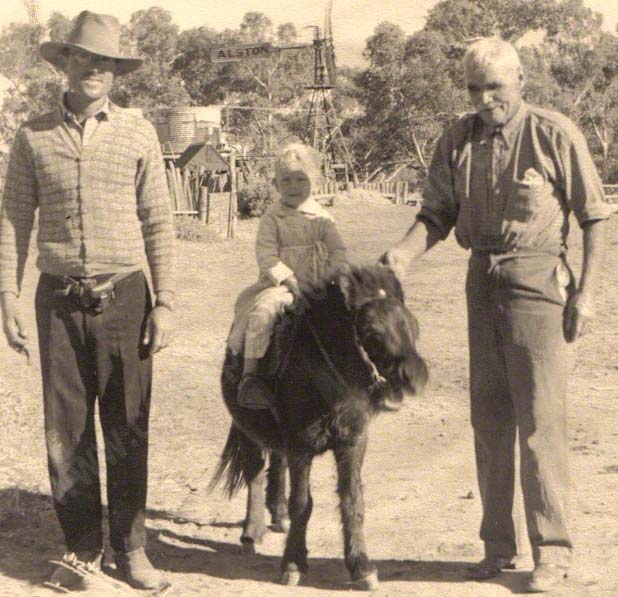 Louie, Harry, and Strat Bloomfield. Photo. Early 1960’s.
Louie, Harry, and Strat Bloomfield. Photo. Early 1960’s.
The camels
 Source – Hayes. Camel train moving along.
Source – Hayes. Camel train moving along.
In some instances the camel wasn’t necessarily faster than a horse but his stamina could outlast a horse, and he could also carry two to three times as much. In the 1900’s right up to the 60’s there was very little in the way of road maintenance or reliable bridges so often the tracks from one place to another were simply animal pads that crossed very rugged regions. It was quite common for camels to come up packed with corrugated iron and all sorts of heavy building materials from South Australia in long Afghan trains.
In the 1930’s Harry’s sister, Peggy, was getting married and Harry was over 100 miles away at a place called Arakillya, junction of the Casey’s and Hale River. He was attending to watering cattle from a well as it was a very dry period. Not wanting to miss the wedding Harry set off on camel to get there, he had no other transport. It took him a day and half to cover the 100 miles.
Another time, Harry was sinking a well on what is now Numery station and received the message of his father’s illness via ‘message on a stick’. The Aboriginals of that time were mistrustful of words written on paper and didn’t understand how it could mean communication and while happy to transport the message, didn’t like to touch the paper. Therefore it was carried in the split or fork of a stick, which they carried as they went on foot cross country. Upon receiving the message Harry used his camel to travel from where he was to Ross River by camel. A friend drove a car out to meet and pick him up. Harry was in time to see his father before he passed away.
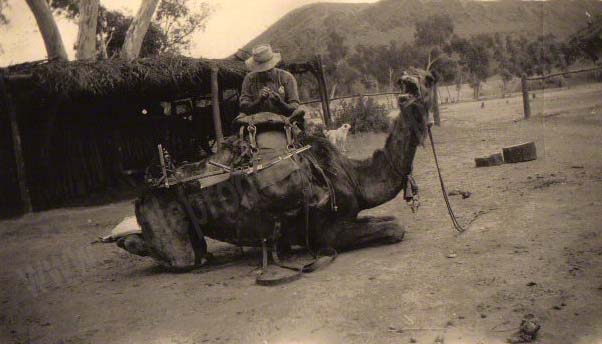 Source Hayes. Harry packing a camel – 1960’s.
Source Hayes. Harry packing a camel – 1960’s.
Camels have no natural predators in the desert and as a consequence of being released or escaping camel populations through WA, NT, SA, NSW, and QLD, especially through the central region of Australia have climbed to plague proportions. They are particularly well adapted to dry conditions and unfortunately due to their body size and shape aren’t that economical to transport, slaughter, and process. A number of efforts have been attempted to build camel processing industries with government support but these have tended to fall over as the costs of capture and handling were simply too high and inefficient
We used to use the camels for a lot of our meat supplies, their meat is very lean and while too dry for slow roasting type meals, is great for mince and steaks. We rarely told staff we ate camels until they worked for us for at least a few weeks as most would turn their noses up and feign disgust at eating camel and declare they never would. When the subject of eating camel meat was invariably bought up at the table, our children would take great delight in telling the staff they’d been eating it for the last two to three weeks, staff had simply assumed they ate beef, the majority of people couldn’t tell the difference.
The camel is a really smart animal, I think actually brighter than most cattle. They can be aggressive if freshly caught but this is more of a fear and fright mechanism. They can strike at you nearly in 360 degrees rotation with their feet, which can be a little intimidating to say the least! Many have been caught in the wild and domesticated very quickly.
Now the camels are mainly used for tours and the following is a picture of one lovely old bloke who seems transfixed by my daughter when very young. This was a friends company http://www.camelexpeditions.com/ who would walk tourists across the desert, the camels are purely pack animals, everyone walks and some expeditions take up to 20 days to cross.
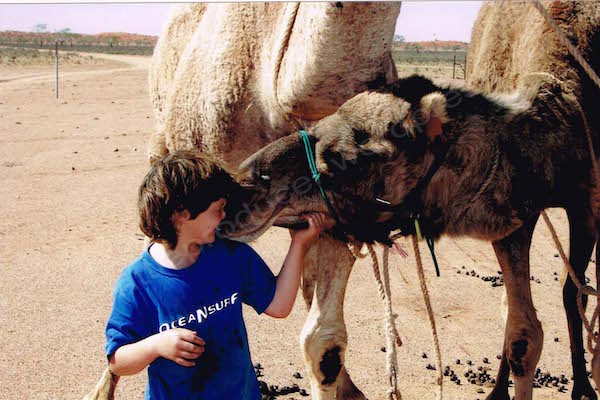 My daughter being kissed by one of the expedition camels.
My daughter being kissed by one of the expedition camels.
Medical evacuations
One particularly nasty incident that occurred early in the 1900’s was when Louie was working cattle at a place called Todd Morden in South Australia. A large horned bullock hooked him off a top rail and ran his horn into his lower stomach, opening his gut and stomach wall from his lower abdomen up to under his chin. The men at the yard carried Louie to the local homestead where they sent word to Oodnadatta for someone to come and help him.
On the Kitchen table with only whisky as anaesthetic and Codie’s Crystals for disinfectant an old bush trained nurse and her daughter washed Louie’s wound and intestines with the crystal solution and stitched him up with 108 boiled horse hair stitches. He survived, and a few years later he married the young lady, Lillian, who had attended him after his injury. Louie lived until he was 74, one lucky man.
We have medical retrieval services in the NT now operated by the government http://www.health.nt.gov.au/hospitals/aerial_medical_services/index.aspx
In the north it is called the aerial medical service while in the south most simply know it as the Royal Flying Doctor Service – RFDS. If we have a medical emergency we ring the local hospital and talk directly to a doctor or nurse. From there they will decide on if the extent of the emergency and logistics of who to talk to and how to organise an evacuation if required.
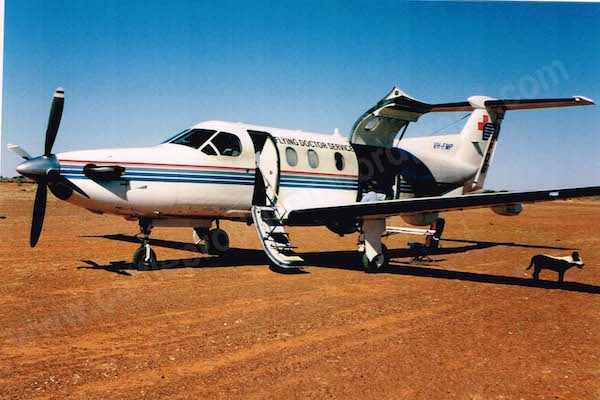 The Royal Flying doctor service in action showing the way the sides open to allow passengers to be lifted in.
The Royal Flying doctor service in action showing the way the sides open to allow passengers to be lifted in.
My father and mother in laws (Pop and Nanna) first dwelling after getting married wasn’t a place of creature comforts, but they made it the best they could with what they had. The bower shed was built. Most were made from the local wood and plants grown in the area.
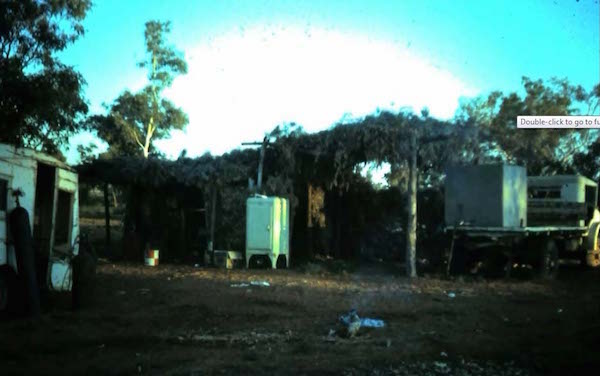 The Bower shed. Cooking was done on a campfire and water was the trucks water tank. Kerosene fridge was used but broke down frequently.
The Bower shed. Cooking was done on a campfire and water was the trucks water tank. Kerosene fridge was used but broke down frequently.
Power generation was by a diesel motor that only went for short periods that was long enough to provide light in the evening and cool fridges and freezers when they came into existence. Early types were only about 6KVA. Most people have no idea what their power usage is, with urban houses and refrigerated air-conditioners these days and all the electronics in the world. I guess at least a 10KVA would be required to run most houses. Earlier producers didn’t usually run very large generators as they simply didn’t have the demands on power that we do now and they only ran them for short periods of the day. 24 hour power is not appreciated unless you have never had it, or you have to pay for repairs to a generator which can blow out to thousands of dollars.
Compare that to my luxurious 24 hour solar, hybrid diesel system with automatic start that requires only an oil and water check and diesel to be added. It is a 12 KVA system and allows me to run a cool room full time, a number of fridges and freezers, computers, fans 24/7, bore pump and pool pump for a couple of hours each day which are on timers. Our generator operates about four to five hours a day to recharge the battery bank and the rest of the time the solar panels charge it to allow 24 hour power access.
Nanna’s stove was a wooden one and was used for all their cooking needs. Located in the kitchen it would have required wood to be collected and carted and it had to be kept going all the time. This made the house even hotter in an area that often exceeds 45 degrees in summer. I have gas, if the gas runs out we change the bottle.
One thing that hasn’t changed I still have Nanna’s original 410 shot gun for snakes. While the snakes I have problems with tend to be pythons eating my chooks or small whip snakes, Sandy had to contend with some of the most poisonous snakes in Australia, 6’ cheeky King Browns.
